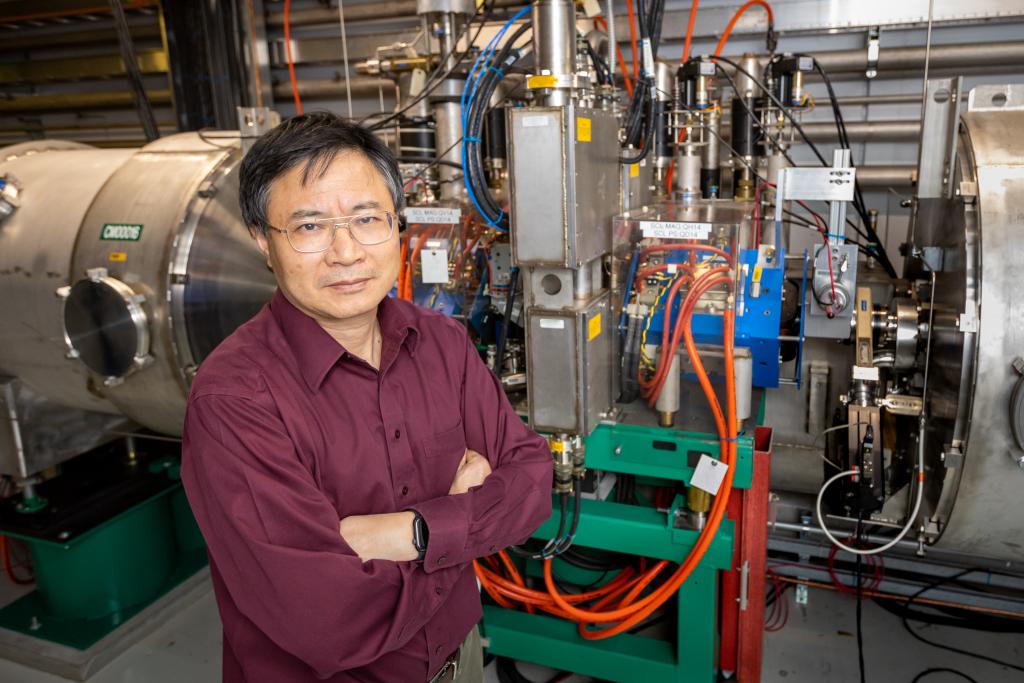
When opportunity meets talent, great things happen. The laser comb developed at the Department of Energy’s Oak Ridge National Laboratory serves as such an example.
This advanced technique, developed by laser scientist Yun Liu, allows physicists to take measurements of particle beams in superconducting linear accelerators in real-time without affecting operations. The measurement captures critical information about changes in the distribution of beam particles. The development and use of this technique solidifies ORNL’s leadership in beam instrumentation and leads the advancement of high-power proton accelerators.
“There is a coherent set of activities within the division for which we are positioning ourselves to be able to execute the next generation of high-power machines,” said Fulvia Pilat, Research Accelerator Division director at ORNL. “This kind of breakthrough sets the foundation to make the strides we need to meet our goals.”
The Faraday Cup Award is the most prestigious recognition among the particle accelerator instrumentation community and the first award of its kind for the lab. The International Beam Instrumentation Conference sponsors the award to recognize outstanding leaps in accelerator science for devices with operational functionality. In the 31 years since its inception, the award has been granted only about half as many times.
ORNL has such an impactful beam instrumentation program because it involves both research and development for novel beam instrumentation.
“We are in a class of our own when it comes to laser-based beam diagnostics,” said Sarah Cousineau, section head for Accelerator Science and Technology at ORNL. “To me, this award validates our research program. It also recognizes Yun’s extraordinary leadership in developing a new class of beam diagnostics tailored specifically to superconducting linear accelerators, which are the future of high-power proton accelerators.”
Scientists use neutrons at ORNL’s Spallation Neutron Source to understand material behavior at the atomic scale under different conditions. Their research creates pathways to advance clean energy technology, upcycling for plastics, artificial intelligence and therapeutic treatments. Each year, thousands of scientists from across the globe compete for beam time at SNS, the world’s most intense pulsed neutron source.
However, producing neutrons requires a high-energy, high-power proton beam. The superconducting linear accelerator at ORNL uses negatively charged hydrogen ions to produce high-energy, high-power protons. The front end of ORNL’s linear accelerator, or linac, shoots pulses of hydrogen ions at 90% the speed of light down a 300-yard-long metal pipe about 4 inches in diameter.
The particles naturally want to fly off the dime-sized ion pulses, or beam. But this flying off, or beam loss, means radiation can occur in places it shouldn’t. It also weakens the ion pulses, which produce fewer neutrons later in the process. Beam loss translates into less beam time for scientists. Considering these factors, regular beamline studies assure safety, pinpoint needed maintenance and maximize beam availability for users.
Combing the beam
Thanks to Liu’s laser comb, the physicists performing these beamline studies have one less limitation. The comb solves the longstanding problem of measuring changes in the beam across time; these measurements were once possible only by taking separate measurements. Instead, Liu’s laser acts as a camera capturing a reel of shots in one click of the shutter. Each tooth of the comb, or laser pulse, captures how the distribution of particles in the beam changes in trillionths of a second. Using Liu’s laser comb, physicists can not only choose sections of beam pulses to measure but also study change and uncover patterns in a single measurement without interrupting accelerator operations.
“Yun’s technique allows us to measure length, which is difficult because the beam flies almost at the speed of light,” said Sasha Aleksandrov, Beam Instrumentation group leader for SNS’s Research Accelerator Division. “Yun found a solution to overcome that limit. It will allow us not only to improve the performance of existing accelerators but also to design much more powerful machines.”
In September, Liu will present a keynote talk on the laser comb at this year’s International Beam Instrumentation Conference in Saskatoon, Canada, where he will also receive the Faraday Award.
“I am very honored and humbled by this award. We have been working on beam diagnostics for more than a decade. I never dreamed that someday we would receive such recognition,” Liu said. “This is a big encouragement not just for me but for a lot of my colleagues. Our group has a lot of experts in different fields that contributed to the success of the project.”
Liu earned a bachelor’s degree in mechanical engineering from the University of Science and Technology of China in Hefei, China, in 1986. He earned a doctorate in electronic engineering from Shizuoka University in Hamamatsu, Japan, in 1994. He took a postdoctoral position at Shizuoka University in 1994 and worked as research staff at the Advanced Telecommunications Research Institute in Kyoto, Japan, from 1996 to 2001. Liu is a senior research staff member in ORNL’s Neutron Sciences Directorate. He has authored more than 100 publications and holds four U.S. patents and three Japanese patents. Liu won an R&D 100 Award in 2013 for creating a way to extract a high-quality laser beam from a broad-area laser array for various laser applications.
SNS is a Department of Energy Office of Science user facility.
UT-Battelle manages ORNL for DOE’s Office of Science, the single largest supporter of basic research in the physical sciences in the United States. The Office of Science is working to address some of the most pressing challenges of our time. For more information, please visit energy.gov/science. — Sumner Brown Gibbs


